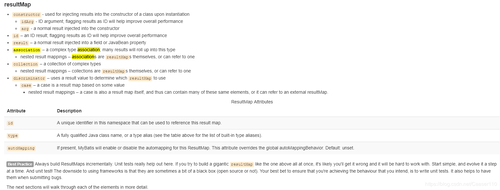学了一下mybatis的查询返回值的集合嵌套,先查了查官网:
这个返回集合有什么用呢?举个例子三张表
hr_job_department
hr_job_position
第三张表里在表示部门和职位的时候只用了上面两张表的主键
但是查询的时候,希望表示下面这样的结果
所以返回值是不止一个对象,这样就用到了集合嵌套
<resultMap id="userInfoMap" type="com.advancedc.hrsys.entity.UserInfo"> <id column="id" property="id" /> <result column="name" property="name" /> <result column="gender" property="gender" /> <result column="id_card" property="idCard" /> <result column="is_married" property="isMarried" /> <result column="phone" property="phone" /> <result column="priority" property="priority" /> <result column="entry_time" property="entryTime" /> <result column="full_time" property="fullTime" /> <result column="created_time" property="createdTime" /> <result column="edited_time" property="editedTime" /> <association property="jobDepartment" column="id" javaType="com.advancedc.hrsys.entity.JobDepartment"> <id column="jdid" property="id" /> <result column="jdname" property="name" /> </association> <association property="jobPosition" column="id" javaType="com.advancedc.hrsys.entity.JobPosition"> <id column="jpid" property="id" /> <result column="jpname" property="name" /> </association> </resultMap>
只需要知道:
(1)column表示数据库字段
(2)property表示Java里的值
而且我这里的主键都是id所以会出现重名的情况,在SQL语句里,查询时就要赋予别名才能加以区分,返回结果resultMap就如上图所示
<select id="queryUserInfoBySomeone" resultMap="userInfoMap" resultType="com.advancedc.hrsys.entity.UserInfo">
SELECT
ui.id,
ui.name,
ui.gender,
ui.id_card,
ui.is_married,
ui.department_id,
ui.position_id,
ui.phone,
ui.priority,
ui.entry_time,
ui.full_time,
ui.created_time,
ui.edited_time,
jd.id jdid,
jd.name jdname,
jp.id jpid,
jp.name jpname
FROM
hr_user_info ui
INNER JOIN
hr_job_department jd
ON
ui.department_id=jd.id
INNER JOIN
hr_job_position jp
ON
ui.position_id=jp.id <where>
<if test="someone.id>0">
and ui.id = #{someone.id} </if>
<if test="someone.gender!=null">
and ui.gender = #{someone.gender} </if>
<if test="someone.name!=null">
and ui.name = #{someone.name} </if>
<if test="someone.idCard!=null">
and ui.id_card = #{someone.idCard} </if>
<if test="someone.isMarried!=null">
and ui.is_married = #{someone.isMarried} </if>
<if test="someone.jobDepartment!=null and someone.jobDepartment.id!=null">
and ui.department_id = #{someone.jobDepartment.id} </if>
<if test="someone.jobPosition!=null and someone.jobPosition.id!=null">
and ui.position_id = #{someone.jonPosition.id} </if>
<if test="someone.phone!=null">
and ui.phone = #{someone.phone} </if>
<if test="someone.entryTime!=null">
and ui.entry_time = #{someone.entryTime} </if>
<if test="someone.fullTime!=null">
and ui.full_time = #{someone.fullTime} </if>
</where>
</select>上图用了INNER JOIN来查询看上去挺简洁的,有一种不简洁的写法如下,虽然也能得到结果,但是不知道性能对比如何
SELECT ui.id, ui.name, ui.gender, ui.id_card, ui.is_married, ui.department_id, ui.position_id, ui.phone, ui.priority, ui.entry_time, ui.full_time, ui.created_time, ui.edited_time, (select id jdid from hr_job_department jd where jd.id=ui.department_id) jdid, (select name jdname from hr_job_department jd where jd.id=ui.department_id) jdname, (select id jpid from hr_job_position jp where jp.id=ui.position_id) jpid, (select name jpname from hr_job_position jp where jp.id=ui.position_id) jpname FROM hr_user_info ui;
点击查看更多内容
为 TA 点赞
评论
共同学习,写下你的评论
评论加载中...
作者其他优质文章
正在加载中
感谢您的支持,我会继续努力的~
扫码打赏,你说多少就多少
赞赏金额会直接到老师账户
支付方式
打开微信扫一扫,即可进行扫码打赏哦








